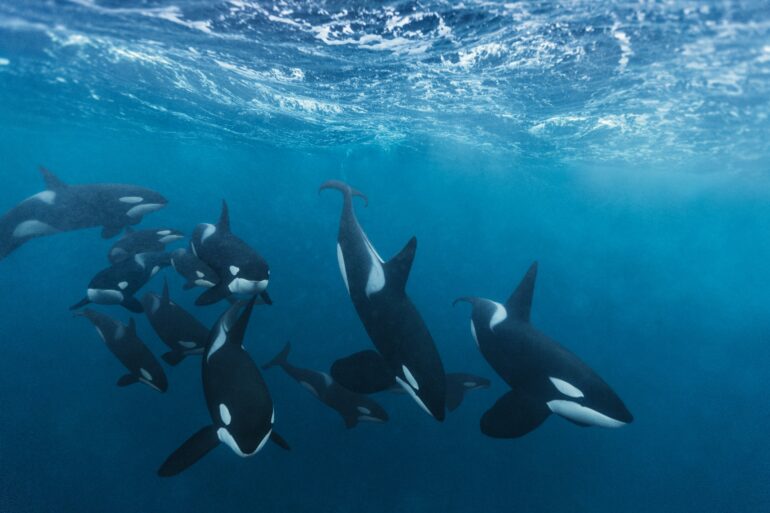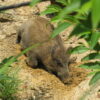A team of behavioral ecologists from the Leibniz Institute of Freshwater Ecology and Inland Fisheries (IGB) and the Humboldt-Universität zu Berlin (HU Berlin) is investigating how animals hunt in groups. Animals in water hunt differently than animals on land, which is partly due to the different size ratio between predator and prey. One example is striped marlin, which belong to the billfish family. Motivation may play a greater role than dominance hierarchy during resource division, but the large fish get out-competed by sea lions when the two predators attack the same prey.
Hunting together is an interesting expression of group behavior in vertebrates. The advantages can be obvious in terrestrial species: multiple predators are often required to capture a larger, stronger prey item. Disadvantage: the prey has to be shared. The diversity and complexity of group hunting strategies is great and are traditionally thought to require high cognitive abilities in the predators. However, advances in tracking technology can now test whether coordination between predators instead emerges from simple rules-of-thumb that do not require high levels of cognition.
While the hunting behavior of top predators such as lions, wolves or orcas is already well studied, the research team turned their attention to groups of larger fish that hunt swarms of smaller fish. To do this, they studied the collective hunting behavior of striped marlin (Kajikia audax), which belong to the billfish family. Striped marlin can grow up to four meters long and weigh up to 200 kilograms (although the researchers studied animals less than half this size). Characteristic is a spear-shaped upper jaw bone which, unlike the swordfish, is not flat and sharp-edged but almost round in cross-section.
Motivation and hunger instead of hierarchy and dominance
Using high-resolution video recordings, the researchers analyzed the animals in the wild in Baja California Sur, Mexico, in the Pacific Ocean, and were able to identify individual animals on the basis of body characteristics and thus examine their individual hunting behavior and their role in the group in detail.
When hunting, the marlin swam in groups around the prey, with individual animals taking turns to attack. The researchers found that competition for prey led to an unequal distribution among the predators: 50% of the most frequently attacking marlin captured 70 to 80% of the fish. Such unequal distribution of prey is also known from land animals.
However, this unequal distribution of prey could not be explained by aggressive behavior, body size or differences in hunting efficiency. “We found that, on average, newcomers had more access to prey. It is possible that the marlin that joined the group were particularly hungry and motivated to eat, and were thus able to outcompete their conspecifics,” explained Matthew James Hansen, researcher at IGB and HU Berlin and lead author of the studies published in Biological Reviews and Communications Biology.
Unlike many group hunters on land, there is no strict hierarchy in marlin that determines the division of prey and the order of consumption—dominance, kinship and social bonds are not the determinants of who has access to prey, when and for how long. One major difference in the open ocean compared to on land is that there is usually no large carcass for several animals to feed on after the kill. Instead, many predators share a large school of fish, which is made up of lots of small, bite-sized prey.
“Since it is very difficult to monopolize a resource when it is comprised of many smaller prey—such as in a school of fish—social hierarchy has probably not prevailed as a driving force for prey division,” explained Professor Jens Krause, who heads the working group at the IGB and HU Berlin.
Predator-prey size ratio may determine hunting behavior
The researchers suggest that the size ratio between predator and prey is an important determinant of hunting behavior in vertebrates.
“In the case of large prey, we assume that the efficient selection of a prey animal from a group and the possible strength advantage that the prey animal might have due to its relative size, play an important role,” said Krause.
However, if the prey is much smaller than the predators, as is the case with school of fish, the individual animals are divided up among the predators before they are killed. In this case, group hunting is mainly advantageous to overcome the prey’s greater maneuverability and the collective defense of the prey, which they gain through cohesive schooling behavior.
Sea lions benefit as kleptoparasites of striped marlin hunts
It is not only groups of striped marlin that prey on the schools of fish in Baja California Sur, sea lions are often part of the action. These predators take advantage of the marlin’s ability to locate prey and force it to the surface. In this mixed-species group hunt, the marlin seem to do all the initial hard work before the sea lions join and make their own attacks. The sea lions are more successful in their attacks than the marlins and dominate access to the prey school, making it difficult for the marlin to make their attacks.
Despite this, the marlin do not react aggressively towards the sea lions. If they can’t access the school because of the sea lions, it is common for the marlin to simply leave and search for a new school of fish. “So it seems that, even though there are many differences in how group-hunting works in the open ocean, kleptoparasitism is also a major factor, just like on land,” said Hansen.
More information:
Matthew J. Hansen et al, Mechanisms of group‐hunting in vertebrates, Biological Reviews (2023). DOI: 10.1111/brv.12973
M. J. Hansen et al, Mechanisms of prey division in striped marlin, a marine group hunting predator, Communications Biology (2022). DOI: 10.1038/s42003-022-03951-3
Provided by
Forschungsverbund Berlin e.V. (FVB)
Citation:
How group hunting works in the open ocean (2023, July 10)



